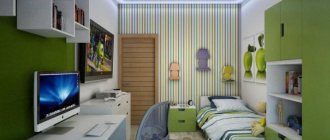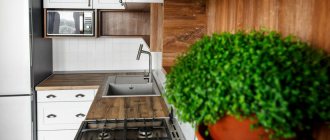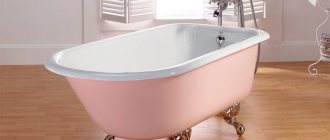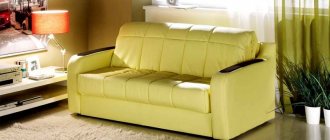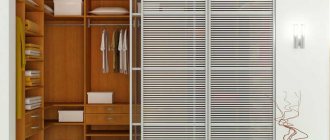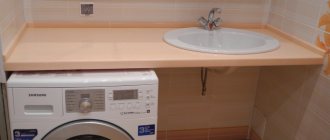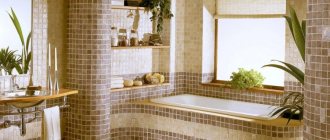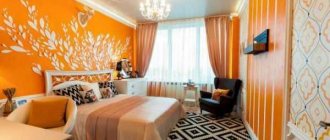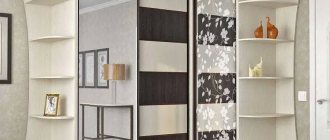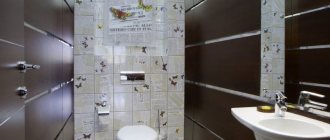Types, their pros and cons
Folding
The folding design is a modern modification of the ropes stretched over the bathtub, on which our mothers and grandmothers dried clothes. It consists of two plastic panels with ropes stretched between them. The panels are mounted on opposite walls (most often - under the ceiling). When the dryer is not needed, one of the parts is removed from the wall and attached to the other. The ropes are automatically pulled into the panel. Depending on the model, you have from 4 to 6 rows of ropes at your disposal.
Pros:
- low cost;
- Possibility of installation in small bathrooms and combined bathrooms;
- ease of operation.
Minuses:
- the maximum load that the folding dryer can withstand is 7 kg;
- in budget models that are not equipped with a pull-up mechanism, the ropes may sag under the weight of the laundry;
- low-quality plastic may crack after just a few dryings;
- if the dryer is located very high, then hanging clothes on it will be extremely inconvenient;
- If you hang bed linen on a dryer placed above the font, then while it is drying, you will not be able to take water procedures.
Sliding
The sliding model has a more interesting design. It is made in the form of a metal console that folds and unfolds like an accordion. The elements of the sliding dryer are connected to each other using reliable rivets. Between the two folding parts there are several metal tubes, which serve as holders for linen.
Pros:
- compact design;
- strength;
- ability to withstand heavy weight;
- ease of use;
- Can be used as a towel holder.
Minuses:
- The small size of the sliding model does not allow you to dry a lot of laundry or large items on it.
Electric
An electric dryer is usually used as a heated towel rail, but it can also be used to dry small items of clothing. The electric dryer is attached to the wall in any convenient place in the bathroom. It is a kind of ladder made of metal tubes. The number of crossbars may vary depending on the model.
Pros:
- wide possibilities for installation;
- if necessary, the electric dryer can be turned off;
- low heating temperature protects against burns;
- Possibility of use as a heater.
Minuses:
- when installing and operating this type of dryer, you must follow the rules for using electrical appliances in rooms with high levels of air humidity;
- lack of space for drying large items or bedding.
20 meters
Such products are also in demand. Among them there are inexpensive cords for various household needs, and not just for drying things. The best ones are included in the rating of quality products.
YORK
The cord is made of plastic. It comes in several bright colors. The classic rope is durable and can be hung indoors or outdoors.
The thread does not stain the laundry. The manufacturer guarantees that its color lasts for a long time. If you fix it firmly, it will not bend.
YORK linen cord
Advantages:
- durable plastic;
- bright colors;
- no sagging.
Flaws:
- none.
Azur
The thread for drying clothes is different from others, which quickly pull out and spoil the appearance of the balcony or bathroom. Thanks to Azur, even your drying area will look stylish. Fasten the cord firmly enough so that it does not sag.
This thread can be stretched between trees. It does not stain clothes, is easy to remove and wash. After this, it can be fixed again.
linen cord Azur
Advantages:
- high quality;
- wear resistance;
- bright color.
Flaws:
- not found.
Smart girl
As the manufacturer indicates, the cord is suitable for outdoor activities and tourism. It is also indispensable in everyday life, gardening, and economic activities. It can also be used in construction and repair procedures and finishing.
The thread diameter is 4 mm. You just need to securely fasten it in the bathroom or on the balcony so that it does not sag. Now you can dry your laundry.
linen cord Umnichka
Advantages:
- optimal diameter;
- reliability;
- wear resistance.
Flaws:
- No.
These products are not expensive, up to 1000 rubles. Many of them supply different colors. Most often, the kit does not include hooks or other fastening devices, but they can be purchased.
Materials
Rope
Rope dryers are considered the most economical. You can make something similar with your own hands, since the material (clothesline) costs very little. Rope dryers are usually long enough, so they can be used to dry clothes from several washes at once.
Steel
Steel clothes dryers are usually chrome plated, so they look impressive and can decorate the interior of the bathroom. Dryers made of steel are very durable and reliable. The only difficulty is caring for them - to maintain the original shine of chrome you will have to purchase special cleaning products.
Aluminum
Aluminum dryers are considered a budget option for steel structures. They are also quite durable, but weigh significantly less. True, the weight of washed laundry that they can withstand is also significantly less.
Plastic
Plastic clothes dryers, despite their lack of durability, are still popular. They are inexpensive, have a simple design and are light in weight. In addition, unlike all other materials, plastic is available in a wide range of colors.
Areas of application
The products can be used not only for drying clothes. They also have another purpose:
- High-quality products with a core are used in fisheries and recreational fishing. They are needed to repair gear.
- Ropes are chosen by tourists to place tents and awnings. They are also in demand among athletes and climbers. Ropeways are made from reliable polyamide cables and are also used for securing loads.
- Household cords will also help when moving. They can be used to tie up boxes and loads to simplify transportation.
- The product is used during road and construction work. It is needed in agriculture, when equipping boats.
As you can see, even household cords can be used for other household purposes. And this is due to reliability and resistance to adverse factors.
Wall-ceiling
The wall-ceiling clothes dryer has two mounting options: between two opposite walls and on the ceiling. The first option is usually used for installation on a loggia, since attaching the dryer to the ceiling there is problematic.
Thin metal tubes through which ropes are threaded act as laundry holders. The holders can be lowered and raised like blinds by pulling a special rope. Since parts of the structure can move up and down, such a dryer is called an “elevator”.
The number of holders can vary from 4 to 10. The weight that the wall-ceiling dryer can withstand depends on this. On average, such models are designed for a weight of up to 20 kg, which is a fairly good indicator.
Choice
How to choose a suitable rope? To find the best option, you should pay attention to several important parameters:
- fastening method;
- balcony size;
- reliability of walls;
- availability of ventilation;
- load.
The first thing you need to pay attention to is durability. This is why you should look at the material. Another rope should be:
- resistant to stretching;
- durable;
- light;
- functional.
These are the main selection criteria that are considered significant. Such products are suitable both on the balcony and outside, indoors. Moreover, it is not necessary to choose expensive goods, because there are high-quality budget options.
Original design
- Folding dryers can be installed on any vertical surface. If it is not needed, you just need to lift the dryer - this way it looks like an unusual panel. By folding the dryer, you can dry towels and small wardrobe items on it.
- Over the door - as the name suggests, these dryers are mounted directly on the door. Hooks are used as fasteners, so after use the dryer can be removed from the door and stored in a secluded place.
- Mobile dryers are also called attached dryers. They are a folding triangular structure that is placed on the sides of the bathtub. The disadvantage of such dryers is that until the laundry is dry, you cannot use the bathroom.
- For batteries - this type of dryer is fixed to heating devices using a pair of hooks. Since batteries are rare in the bathroom, such models are most often installed in other rooms and are used mainly for drying towels.
This is interesting: Corner or semicircular cornice for the bathroom? Overview of standard solutions
Design
When choosing a rope, you need to look at its design. Stability and reliability depend on it. 2 technologies are used in production:
- Torsion.
- Weaving.
Torsion is a common technology that involves the use of 3 strands. First they are twisted in one direction, and then together in one direction. After this, the product is rotated in a different direction using a common beam. Stiffness is affected by the amount of torsion.
The soft rope has few twists, so it is strong. It also has little stretch, but is abrasion resistant. Her strands usually break out when caught. There are a lot of twists in hard ropes. They stretch under load.
This twisting technique is used to create threads from natural fibers. Cheap production is considered an advantage. Braided ropes can be spliced by weaving in the ends to make the product look monolithic.
Weaving is the second popular technology, which is considered more complex. For production, special machines are used that work with a large number of strands. The result is ropes with and without a core.
Braided threads unravel at the ends. Since synthetic and artificial fibers are used in the creation, this problem is solved through conventional firing. You just need to burn the end of the cord with a match. Only the procedure should be performed carefully, since individual fibers are flammable.
Accommodation
- Most of us wash all the laundry that has accumulated over a certain period in one day, making several “approaches” to the washing machine. Thus, the dryer ends up with clothes from several washes at once. In order not to test the strength of interior partitions, choose a solid wall for installing the dryer, preferably a load-bearing one. This way you will be sure that the wall will not gradually begin to crumble under the weight of wet laundry.
- When choosing a place for the dryer, keep in mind that it will be unfolded from time to time. While the laundry is drying, you should be provided with free access to all plumbing fixtures and cabinets.
- Try to place the dryer as close to the ventilation system as possible - this way the laundry will dry faster and excess moisture will evaporate in time. Monitor the condition of the fan and clean it periodically.
Properties
When creating products, several specifications are taken into account. This affects the technical parameters of the finished product. For example, household cords with and without a core have different elongation. It is believed that the core reduces the risk of chafing of the product and makes it durable.
Household ropes absorb energy under shock loads. Many materials do not rot, are not affected by mold or rust. But you should not allow the cable to come into contact with organic solvents or acids.
Athletes and climbers choose household cords for their lightness and flexibility. Another advantage is resistance to UV rays. Synthetic cables retain their properties during temperature changes and are easily cleaned of dirt, since dust and dirt do not accumulate in the fibers.
Installation
- Installation of a wall-mounted dryer should begin with choosing the most suitable location. Read about placement requirements in the previous section.
- Please read the installation instructions carefully before starting work. It contains recommendations specific to this particular dryer model.
- Now take the bracket on which the structure will be attached and attach it to the wall in the selected location. Through the through holes, mark the locations of future fasteners.
- In accordance with the markings on the wall, drill the required number of holes.
- Secure the brackets to the wall using the set of fasteners included in the kit.
- Attach the remaining dryer parts to the brackets following the instructions in the assembly manual.
Care instructions
To maximize the service life of the product, it is necessary to adhere to the operating requirements, not exceed the permissible loads and take care of the dryer. Maintenance rules depend on the material of construction.
For example, it is recommended to wipe plastic devices after each drying. In this case, you should not use products with an aggressive composition. Stainless steel products are the least demanding to maintain.
If the frame is powder coated, care must be taken to ensure that it does not crack. Otherwise, the resulting chips may accidentally damage the laundry. You should also periodically check the condition of the cords and replace them if necessary.
How to do it yourself?
Method 1: Rope Clothes Dryer
The most basic version of a homemade wall dryer is a system of hooks and ropes stretched over the font. To begin with, we purchase all the necessary materials from the hardware department (instead of hooks, you can use thick fishing line or beautiful wire). Then we make markings on two opposite walls to which our dryer will be attached. We mark the locations of the hooks: they should be located on the same line at an equal distance from each other. After this, we drill holes in which we then fix the hooks. We cut the rope into equal parts and pull it between the hooks. The rope dryer is ready!
Method 2: overhead clothes dryer
In order to build a more permanent structure, you will need more free time and tools for woodworking. We will make the dryer from wooden slats with a cross-section of 2 cm. First, you need to cut the components of the structure: cut two bars equal to the length of the bathtub and 6-8 bars equal to its width. We sand the sawn bars.
We place the long bars at a distance slightly less than the width of the bathtub and begin to nail the short bars to them. It is the short bars that will serve as holders for linen. You need to try to keep the same distance between them so that the dryer is not only reliable, but also beautiful. The finished dryer can be painted in any color that matches the interior of your bathroom.
Clothes dryers in the bathroom interior. How to choose
For a small room, a hanging type design is suitable. It is convenient and does not require disassembly or assembly. The system does not cause any trouble, the internal space is free to move. Manufacturers offer special removable designs. This product, which fixes the rope, is installed on the protruding parts of the wall on the sides.
They take up minimal space, can withstand heavy loads and can be almost invisible to the eye.
For free access to bathroom items, after use you can remove the hinged part by securing it on the opposite side. Due to its compactness, it can be deployed for action if necessary. This device is also called an exhaust modification.
If it is impossible to install a folding system, when the area is occupied by a washing machine and sink, an original bathtub dryer will be your salvation.
There are portable models that can be placed anywhere.
If space allows, you can choose a folding stand. Thanks to the folding mechanism, you can keep it anywhere. When the laundry is completely dry, you can hide the pantry or closet. To speed up drying, it is better to install the device near the ventilation system.
A folding dryer with special flaps, which can be used to increase the hanging area.
If your home wash does not exceed three or four kilograms, you can give preference to a portable option by attaching it to a heating radiator.
What types of wall-mounted clothes dryers are there, review of models
For many people, drying clothes after washing can be a challenge, especially when there are a lot of items to dry. Bathrooms and balconies usually have small areas; drying facilities are not always provided. Then you should think about purchasing special structures for hanging laundry after washing. There are various types of devices on sale that can be installed in any room and can be easily folded after use. This design is considered a wall-mounted clothes dryer, convenient in any bathroom, regardless of its size, because it is installed directly on the wall. But it’s worth considering all the features of the device in advance.
This is interesting: How to choose a toilet seat with a microlift?
Advantages and disadvantages
For many people, the dryer is the only solution for drying washed clothes. But the size of the room simply does not allow for the installation of large structures. But due to the fact that many stores are simply overwhelmed with a variety of devices of this type, choosing a compact, but at the same time multifunctional model will not be difficult. A wall-mounted clothes dryer for the bathroom combines all these qualities, and it is suitable for bathrooms of any size.
This device has a number of advantages:
- compact dimensions - wall structures have small dimensions, so they can be easily used anywhere;
- functionality - the models of these products have a sliding design, which, if necessary, can be expanded into a wide area for drying things and folds into a compact product;
- Easy installation - you can easily install it yourself. To do this, you do not need to have much experience, you just need to have available equipment and desire;
- simple operation - using these products is easy, it does not require superpowers;
- strong base - often made of durable materials - high-strength plastic, iron.
A bathroom dryer may also have negative features:
- Wall structures are not always large; they often have a small area for drying;
- low degree of load - the maximum load can reach up to 10 kilograms;
- low strength of fastenings - under the weight of laundry, fastenings wear out, crack, and break.
Types of wall-mounted clothes dryers
Wall products can be produced in different types and types, but they are all installed on walls. They can have a stationary or sliding design. To understand the features of these products, it is worth carefully considering all types and their characteristics.
Stationary
Stationary structures are conventional rope dryers. They consist of stretched ropes. A rope dryer is usually installed above the bathtub. Since it has a fairly compact size, after installation it does not bother anyone and fulfills its purpose.
Roller rope products are considered the best option for stationary products. The main advantage of these products is that they can be used even if there is no full access to the entire length of the rope. The rope is fixed on rollers, it can be easily moved; to do this, just pull the area of any of the parts, pushing towards you the thing that is difficult to reach.
Stationary ones can be installed in the bathroom, on balconies. Often roller structures are installed on loggias, on the streets near a window. Roller ones provide full access to the entire surface of the ropes and prevent clothes from suddenly falling when hanging.
Positive qualities of structures:
- compact dimensions;
- easy installation;
- simple design that you can make yourself;
- low cost;
- easy to use.
Sliding
A sliding dryer can be installed in bathrooms and on balconies. These products have a second name - “accordion”, since they are quite similar to this product.
Features of the sliding product:
- a structure of this type is installed on the surface of the walls and, if necessary, extends;
- this type of dryer is made of tubes made of metal material, which are secured on both sides by a special mechanism;
- products of this type can withstand increased loads; they can hang up to 10 kilograms of laundry;
- move apart quite widely, from 5 to 10 tubes;
- narrow in width from 500 cm to 1 meter 20 cm.
Folding
One of the popular products for drying clothes is the folding design. Products of this type consist of several parts, one is stationary, which is attached to the wall surface, and the other is mobile, it is attached to hooks on the opposite wall. The stationary part has a rotating drum on which ropes are wound.
The ropes are stretched with a slight degree of reinforcement. Once the items are completely dry, the mobile part is removed from the hooks and the ropes return to their place by inertia.
You can make this type of dryer yourself. To do this, you need to secure the ropes of the required length using slats, then they are wound onto the drum. Any cylindrical object can be used as a drum. But still, purchased models are considered the best option. This is due to the fact that their winding is carried out automatically; if desired, you can tighten the drum to tension the ropes. These products can be folded independently.
This is interesting: Spectacular accessories: making the bathroom stylish, harmonious and cozy
Positive qualities of structures:
- when folded, they take up little space;
- easy operation;
- can be used for small rooms - for bathrooms, balconies;
- low cost.
But there are several disadvantages:
- can withstand weight up to 6-7 kilograms;
- during frequent use, sagging of the ropes is observed;
- the basis of these structures is made of plastic material, which has low strength.
Varieties
What types of cords are there? Their difference lies in the material. They also have different characteristics. You can purchase goods not only in a hardware store, but also order them online in an online store.
Plastic
Such cords are durable, elastic, and come in different colors. They are comfortable and high quality. Plastic cannot tear or break. It is also resistant to aggressive environments. Inside there are intertwined metal threads that are coated with a reliable polymer. Therefore, cable rods do not rust and do not stain things.
Dirt on plastic is very easy to clean. The coating is made from environmentally friendly raw materials. Such cords can be selected for both indoor and outdoor areas. Although the plastic is durable, it can stretch and sag under load. Periodically the product will have to be tightened.
Cotton
Cotton cord is durable and strong, environmentally friendly. It does not emit harmful substances, as it is made from high-quality threads. Such ropes are light, soft, elastic, and at the same time wear-resistant. High quality ensures reliability and durability.
An environmentally friendly rope can last a long time. But during use it sags, gets wet in the rain, and loses its appearance. The material may not withstand heavy loads. Cotton is difficult to care for because it absorbs dust and gets dirty instantly.
Jute
Jute is considered a natural material that is created from the plant of the same name. It is durable, reliable, environmentally friendly, so ropes made from it are of high quality.
Jute cords are weather resistant. They can be chosen for drying children's clothes because they do not emit hazardous substances. Jute is also tear resistant.
Although there are now a lot of synthetics, the price of which is lower, many still choose jute ropes. And they are valued for their resistance to rotting. Not every product has this property.
Polyamide
This is a synthetic thread for drying clothes. The composition includes polyamide, nylon, nylon. This rope is resistant to wear and mechanical factors. It is also tensile strength, flexible, and lightweight. A special feature is the ability to withstand large amounts of laundry.
The core is made of polyamide, the fibers are made of propylene. This rope is considered a combination rope: it is light, durable, and can be used for a very long time. It can be attached to the wall on the balcony or in the bathroom.
Polypropylene
The cord made of polypropylene threads is lightweight, resistant to temperature fluctuations, aggressive factors, and abrasion. It also does not crack, does not absorb moisture, and is also easy to clean. The polyamide core makes the product stronger.
Polypropylene rope is created from reliable polypropylene threads. Thanks to the combination of synthetic materials, reliable mechanical characteristics are ensured. Even with heavy clothing, the product does not sag.
All presented types of linen cords are ideal for household use. All that remains is to secure them correctly for reliability. If the thread is of high quality, reliable, durable, it will last for a very long time.
Mobile or portable dryers
The most popular option for a floor clothes dryer is a folding design that looks like an ironing board.
Also, quite often housewives choose dryers on wheels, which are easy to move from one room to another.
Both models are made of metal, and they are particularly strong and durable, since they have a simplified design without rollers, brackets and other devices.
Portable dryers include a model resembling a book with special support bars. It is necessary to place such a dryer on the bathtub itself, focusing on the edges of the container.
